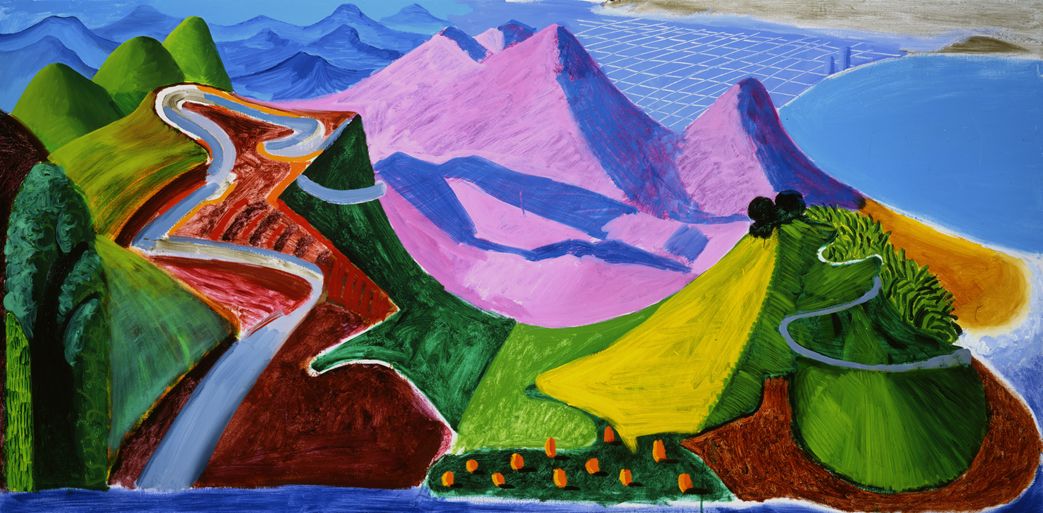HOCKNEY’S MOUNTAIN DRIVE AND THE THEATRE OF DREAMS

Most of us will remember those endless car journeys as kids where we were held hostage by our parents' soundtrack (sometimes for our own good) as we lost all sense of time and where only occasionally certain music alleviated the tyranny of those interminable drives. Perhaps later, some of us found as we got older that we could command and curate the soundtrack better suited to our personal taste and thereby make the experience of travel far more pleasurable for our fussy souls.
Alex Ross wrote a beautiful article for The New Yorker entitled 'A Road Trip With David Hockney And Richard Wagner' (11/09/21) in which he describes a track-specific playlist that had been compiled by the British artist for his "large-scale audio-visual work" entitled 'Wagner Drive' that started out with Bernstein's 'West Side Story' and ended with Wagner's 'Tristan Und Isolde'.
The idea is to set off on a road trip from Malibu into the Santa Monica Mountains as the interplay between landscape and music becomes completely symbiotic as one seamless totality of sound and visual.
"After four and a half miles, we turned right on Piuma Road, which climbs seventeen hundred feet, to the top of a ridge. At almost the same moment, the mystical prelude to “Parsifal,” Wagner’s final opera, began to unfurl. The weightless sonorities and blended timbres of the composer’s late style suited the veering, dissolving perspectives of the drive: sun-drenched south-facing mountains, purple-tinted inland ranges, road-hugging rock faces, occasional vistas of a now distant ocean. A hilltop mid-century-modern home, struck by the slanting winter sun, became a sleek update of Monsalvat, Wagner’s Grail Temple. The brass choir of the Dresden Amen harmonized with the mountain-and-ocean panorama of the Malibu Canyon Overlook."
This unique concept of road trips as giant artworks fascinates me and makes complete sense to someone who has always prided himself on having a deep appreciation when it comes to enjoying the cinematic relationship between music and image. Sadly, the closest I've ever really come to replicating this type of epic experience was bombing down the M5 in a friend's car while listening to an RCA recording of Verdi's 'La Forza Del Destino' with Leontyne Price and Placido Domingo, except, rather than mountains we merely glanced at the magical glowing royal blue lights of Windsor Castle and were momentarily hypnotised by the Lucozade factory with its mesmeric orange neon signage. Of course not quite comparable to the stupendous delights of Alex Ross's Californian 'nacht' odyssey as described here:
"Nine minutes before sunset, we turned left onto Las Flores Canyon Road, which would lead us back to our point of departure. The soundtrack was now Siegfried’s Funeral Music, the memorial to the failed hero of the “Ring.” The first part of this descending leg took place in deep shadow, as the road briefly swerved north before heading back south. The muffled drumbeats of Siegfried’s funeral procession matched the loss of light and the onset of a nighttime chill. As Hockney intended, the orange disk of the sun reappeared over a gray-blue ocean just as the orchestra moved into the major and intoned Siegfried’s leitmotifs at high volume—a magnificent, valedictory mood. None of the filmmakers who live in the vicinity could have more perfectly choreographed this golden-hour blend of sight and sound."
Comparisons are odious of course, but I do now remember one other such moment of similar, multi-sensory perfection.
My middle brother had secured some tickets to go watch Manchester United play Dynamo Kiev (courtesy of a notorious 'kiss and tell' tabloid newshound') in a Champions League group stage match as a couple of his beleaguered restaurant staff drove us from the place he was working in Surrey to Old Trafford, Manchester. Frazier our burly Scottish driver was a reliable pair of hands behind the wheel as we (mostly) hurtled up the M25 toward that sacred sporting temple in the North of the country otherwise known as the 'theatre of dreams'.
Traffic was heavy that afternoon and we were all a little concerned about the stop/start broken rhythm to our journey until I remember (like it was yesterday) we hit a profound break-through moment where the blazing white sun seem to warm up our tiny vehicle as it penetrated through our windows and somehow magically appeared to clear all the traffic around us just like the parting of the red sea.
"You Stole The Sun From The Heart' by the Manic Street Preachers was simultaneously our soundtrack on the radio at that moment and suddenly we found ourselves in a heightened state of cosmic alignment sensing destiny would not betray us; nothing could possibly now stop us from seeing Manchester United as we had been evidently blessed by the Sun God who had cleared our path ahead like some benign deity.
Anyway. Back to Alex Ross. ^^
"Eventually, as in every Hollywood phantasmagoria, illusion surrendered to reality. The Funeral Music wound to its close as the road straightened out and houses became crowded together. Malibu’s beach culture reasserted itself: weathered Siegfrieds toted surfboards back to their cars. Wagner’s grandeur took on an ironic, melancholic tinge, promising a state of transcendence that contemporary existence was bound to foreclose. Still, when the sun plunged into the ocean on cue, it was like no other sunset I had seen—the final frame of a live film with an invisible director."
I recently wrote about the film 'Aria' (1987) making reference to the "Wagner's Liebestod" neon/dusk sequence starring Bridget Fonda and James Mathers as the ill-fated lovers who travel through the desert into Las Vegas set to the soundtrack of Isolde's final Act 3 aria.
Now I'm thinking, perhaps this was the original inspiration for Hockney's more epic version that Alex Ross and his friend were so lucky to enjoy (the bastards!)
Still, I'll always have the M25 and the Manics, I suppose.